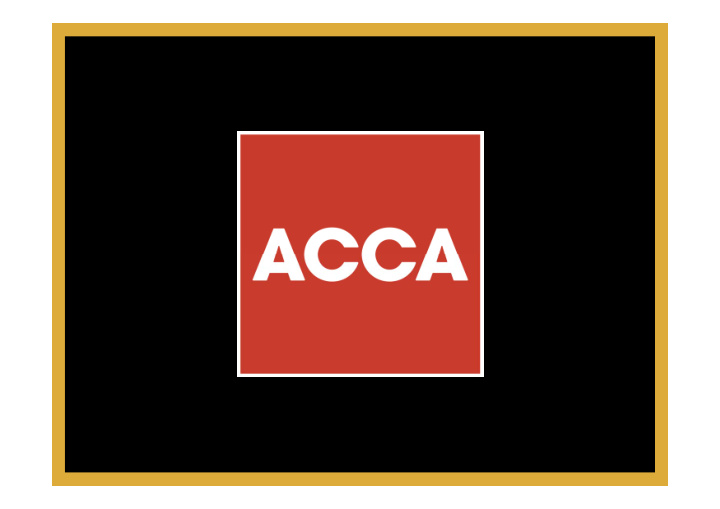



PAST EXAMS REVIEW OF
ARTICLES Key advice Teaching tax Exam reports & teach accounting So nothing really new to add
DONE WELL? WHAT WAS
WHAT WASN’T DONE WELL?
JUNE 2009 High pass rate of 63% compared to the other skills papers Areas, such as NIC, that previously caused problems handled with ease Time wasted calculating gains for exempt assets
DECEMBER 2009 Another good performance with a pass rate of 51% Questions 1 & 4 were very well answered Problems with Question 3: • Base costs not shown • Business treated as one disposal • Restriction of incorporation relief not known • Poor workings for PPR exemption • Letting relief missed
JUNE 2010 Papers getting a bit predictable Pass mark out of line with other skills papers Therefore style of the paper slightly different Aim of making students think a bit more in order to achieve a pass mark Will also better prepare students who carry on and sit paper P6 (UK)
JUNE 2010 (continued) Pass rate of 46% in line with an average for skills papers Questions 1, 2, 3 & 5 all reasonably well answered Problems with question 4: • Lost easy mark not stating that actions were tax evasion • Use of common sense re marks for ethical viewpoint as regards non-disclosure • Wrote about an enquiry even though right to raise an enquiry expired • Little knowledge of discovery assessment despite being given some help No awareness of new penalty regime •
DECEMBER 2010 Satisfactory performance with a pass rate of 39% Questions 2, 3 & 5 were well answered, especially question 3 In question 1 students were obviously not expecting a section on PAYE Question 4 needed some careful planning before attempting the fairly straightforward calculations
DECEMBER 2010 (continued) Question 1 – Revision notes P11D = benefits P60 = end of tax year P45 = leaving Question 4(a) – Calculations Motor car - Benefit £80,000 x 35% - Income tax £28,000 at 40% - No employee NIC implications Director’s remuneration - Income tax £26,000 at 40% - Employee NIC £26,000 at 1%
WHICH AREAS NEED TO BE IMPROVED?
DO NOT WASTE TIME: Doing unnecessary calculations Redoing entire calculations to correct just one omission By not using common sense - for a 2 mark section an answer should only be two or three sentences or calculations Writing notes and explanations when not required Having more workings than are necessary Saying the same thing twice or in more detail than is necessary
WHERE CAN TUITION PROVIDERS HELP?
PASSING F6 Key to passing F6 is picking up the easier marks as quickly as possible A well prepared student will then have in the region of 40 marks, leaving time to gain sufficient of the harder marks to achieve a pass With practice questions a mark of 7/10 in 15 minutes is better than 10/10 in 30 minutes Make sure answers are easy to follow Poor presentation can mean not getting full credit for an answer if it is difficult to follow
ARTICLES Updated examiner’s approach Finance Act 2010 Inheritance tax (2 parts) Capital gains tax (2 parts) Value added tax (2 parts) Groups Overseas aspects of corporation tax
FOCUS ON FUTURE EXAMS
JUNE 2011 ONWARDS Questions 3, 4 & 5 will each be for 15 marks More than one topic could be examined in questions 4 & 5 Groups and overseas aspects of corporation tax may be examined in question 5 for 15 marks VAT section of the syllabus expanded by inclusion of group VAT registration, imports, exports and trading within the EU Will continue to include aspects where students are required to think about their answers in order to obtain good marks
INHERITANCE TAX A basic understanding of IHT added to the syllabus In either question 4 or 5 for up to 15 marks Actual nil rate bands will be used for prior years, but no reliefs are examinable Most important syllabus areas are: • 7 year accumulation principle • IHT liabilities on lifetime transfers • IHT liability on a death estate • Annual exemption and spouse exemption • Payment of IHT
WHAT’S NEW?
FINANCE ACT 2010 New information to be given in tax tables: • Income tax rates for dividends • Income limit for the standard personal allowance • Inheritance tax rates and taper relief details FA article has examples covering the additional rate of income tax and the reduction of the personal allowance
INTERNATIONAL ACCOUNTING STANDARDS IAS terminology will be used when presenting accounting information. The following terms will be used: • Income statement • Sales revenue • Non-current assets • Inventory • Loan notes Income statements will be presented in IAS format
PENSIONS ANNUAL ALLOWANCE For June and December 2011 sittings a calculation of the additional tax charge will not be required Calculations are now quite complex
CORPORATION TAX ACT 2010 Following terms will be used: • Taxable total profits • Total profits (for loss relief questions) • Augmented profits • Small profits rate • Main rate
CAPITAL GAINS TAX A question will not be set where a disposal is made before 23 June 2010 or involving entrepreneurs’ relief limits prior to 23 June 2010
STANDARD RATE OF VAT A question will not be set involving a VAT period where there is a change in the rate of VAT However, a question involving the quarter ended 31 March 2011 might state that there were no transactions during the period 1-3 January 2011
PENALTIES The new penalties for late filing of returns and late payment of tax are being introduced as and when HMRC have the resources available It is assumed that the new penalties will apply for self- assessment, even though their introduction is not as yet definite
Recommend
More recommend